.
H.G. WELLS' BARSOOM!
CONTENTS
Introduction
H.G. Wells' Mars
H.G. Wells' Martians
on Mars
Barsoomian
Creatures on Wells Mars? Apes and Men, oh My!
Wellsian
Creatures on Barsoom: Kaldanes and Rykors, Oh My!
Locating Wells'
Martians on Barsoom
Evolution
of Wells' Martians on Barsoom
A Little Problem
John Carter's
War of the Worlds
 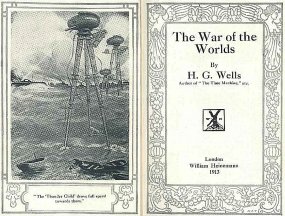 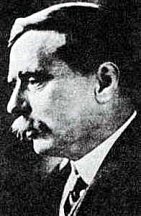
Edgar Rice Burroughs
~ War of the Worlds Frontispiece and Title Page 1913
~ H. G. Wells
Introduction
 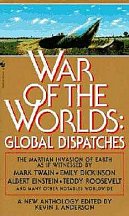
It is now an established literary conceit to
merge Edgar Rice Burroughs' Barsoom with the malignant Martians of H.G.
Wells. It’s been done by George
Alec Effinger, in “Mars: The Home Front,” in the Kevin J. Anderson
anthology War of the Worlds: Global Dispatches as well as by Alan
Moore at the opening of his second volume of The League of Extraordinary
Gentlemen.
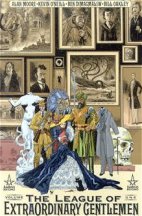 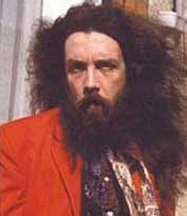 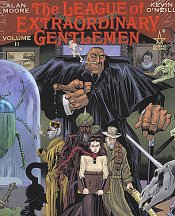
Further, fans and theorists, including the Wold
Newton people, have written extensively of the mixing and matching
of the worlds. Personally, I tend to take the Wold Newton stuff
with a grain of salt, those people have too strong a tendency to discard
inconvenient facts and invent imaginary facts to make their theories fit.
But nevertheless, H.G. Wells’ Mars and Burroughs' Mars
have been mixing reputably and disreputably for quite some time now.

Well, what of it? After all,
both A Princess of
Mars and War of
the Worlds are in public domain, and any author is free to mix
and match them in any old way. They are both Mars stories,
written originally in or around the same era, and arguably the most famous
such stories of the age. Joining them up is as natural as Frankenstein
vs. Dracula. After all this time, the urge to merge them as
some sort of pastiche is as natural and relentless as gravity.
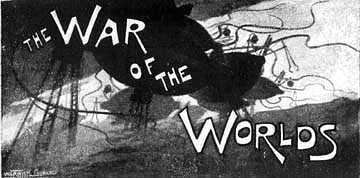 But is this simply a Frankenstein creation, a lumbering crudely
sewn monster, bolts sticking out of its neck, swinging about wildly as
mismatched parts grind together? Or is there the possibility
of something more elegant?
But is this simply a Frankenstein creation, a lumbering crudely
sewn monster, bolts sticking out of its neck, swinging about wildly as
mismatched parts grind together? Or is there the possibility
of something more elegant?
Can we actually go into H.G. Wells, version of Mars and
Martians and find traces that we could call Barsoom? Is it
possible to look through the Barsoom stories and find things that would
point towards Wells’ invaders? Could we actually locate
the home of Wells’ Martians on Barsoom? Could we find related
species? Can we place Wells invaders in an ecologically and
evolutionarily sensible context on Barsoom?
In short, can Wells Mars and Martians, and Burroughs Barsoom
be fit together?
I think that the answer to all these questions, is yes.
H.G.
Wells' Mars
On the surface, the world of Barsoom has no place for
the implacable Wells' Martians. And on the other side of the
coin, it hardly seems that Wells contemplated humans or white apes or green
men on Mars. And yet, if we study the canon carefully,
there does seem to be a bit of imaginative scope within Wells which might
admit to mixing in Barsoom.
Let us consider the Mars delivered to us by H.G. Wells.
From War of the Worlds, published in 1898, there is this broad description:
“The planet Mars, I scarcely
need remind the reader, revolves about the sun at a mean distance of 140,000,000
miles, and the light and heat it receives from the sun is barely half of
that received by this world. It must be, if the nebular hypothesis has
any truth, older than our world; and long before this earth ceased to be
molten, life upon its surface must have begun its course. The fact that
it is scarcely one seventh of the volume of the earth must have accelerated
its cooling to the temperature at which life could begin. It has air and
water and all that is necessary for the support of animated.
Nor was it generally understood that since Mars is older than our earth,
with scarcely a quarter of the superficial area and remoter from the sun,
it necessarily follows that it is not only more distant from time's beginning
but nearer its end. The secular cooling that must someday overtake
our planet has already gone far indeed with our neighbour. Its physical
condition is still largely a mystery, but we know now that even in its
equatorial region the midday temperature barely approaches that of our
coldest winter. Its air is much more attenuated than ours, its oceans have
shrunk until they cover but a third of its surface, and as its slow seasons
change huge snowcaps gather and melt about either pole and periodically
inundate its temperate zones. That last stage of exhaustion, which to us
is still incredibly remote, has become a present-day problem for the inhabitants
of Mars. Their world is far gone in its cooling and this world
is still crowded with life...”
The remark about oceans still covering a third of the world
suggests that even at this time, there was still some consensus that the
dark spots were oceans or seas. But even by this time, the idea was
being increasingly adopted that Mars oceans were gone, or at best, damp
remnants.
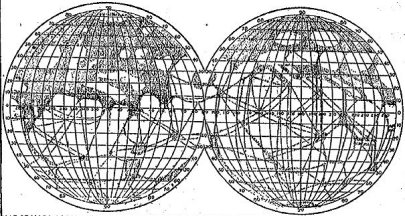 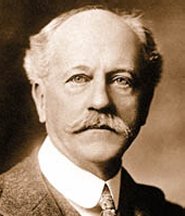
Lowell's
Mars
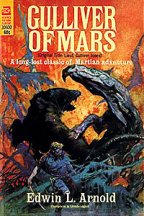 The picture of Mars here as a dying world, its oceans withering, its air
attenuated, is not significantly different than the one Percival Lowell
would develop, or that Arnold in his Gulliver Jones might embrace.
It’s not too different from Burroughs' Barsoom, and in fact, in loose terms,
it represents the state of science knowledge and thought.
The picture of Mars here as a dying world, its oceans withering, its air
attenuated, is not significantly different than the one Percival Lowell
would develop, or that Arnold in his Gulliver Jones might embrace.
It’s not too different from Burroughs' Barsoom, and in fact, in loose terms,
it represents the state of science knowledge and thought.
But Wells gives us a little bit more of his Mars.
The year before
War of the Worlds, he wrote a story called “The
Crystal Egg,” which stands as a sort of indirect prequel to War
of the Worlds. The story concerns an odd crystal object
in a vendor’s curio shop, and a Mister Cave, the proprietor of the shop
who discovers that he can see into the crystal, into another world, Mars.
Mister Cave’s world is identified as Mars within the story,
and for very good reasons. This world has a regular cycle of day
and night equal to our world, the sun is a little smaller, the midnight
sky a little darker, it has two small swiftly moving moons, and most
damning, the same stars and constellations, Sirius, the Pleiades, Aldebaran,
and the Great Bear, in our sky are recognizable on this world. . .
Which must mean that it is within the same solar system!
And the fact that the stars and constellations are the
same, means that the crystal egg is giving a glimpse into a location on
the northern hemisphere of Mars.
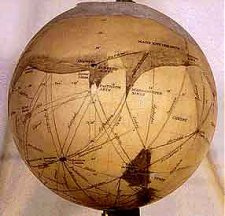
H.G.
Wells' Martians on Mars
It isn’t clear whether Wells had War of the Worlds
in mind when he wrote “The Crystal Egg.” It’s quite possible,
that he’s got two different Mars in mind. In the Egg, Wells
describes three kinds of apparent being on Mars, the predominant one being
a winged flyer. But there is another Martian race, larger and
more dangerous, consider this excerpt from the short story:
“...on the causeways and
terraces, large-headed creatures similar to the greater winged flies, but
wingless, were visible, hopping busily upon their (two) hand-like tangle
of tentacles....Mr. Cave was unable to ascertain if the winged Martians
were the same as the Martians who hopped about the causeways and terraces,
and if the latter could put on wings at will. He several times saw (animals)
feeding among certain of the lichenous trees, and once some of these fled
before one of the hopping, round-headed Martians. The latter caught one
in its tentacles, and then the picture faded suddenly and left Mr. Cave
most tantalisingly in the dark.”
My, my. So here Wells has large-headed or round-headed
Martians, wingless, with two tangles of tentacles, which move around the
ground and preying upon other creatures. Now, compare this
description, from War of the Worlds:
“They were, I now saw,
the most unearthly creatures it is possible to conceive. They were huge
round bodies - or, rather, heads - about four feet in diameter, each body
having in front of it a face. This face had no nostrils- indeed, the Martians
do not seem to have had any sense of smell, but it had a pair of very large
darkcoloured eyes, and just beneath this a kind of fleshy beak. In the
back of this head or body- I scarcely know how to speak of it - was the
single tight tympanic surface, since known to be anatomically an ear, though
it must have been almost useless in our dense air. In a group round the
mouth were sixteen slender, almost whiplike tentacles, arranged in two
bunches of eight each. These bunches have since been named rather aptly,
by that distinguished anatomist, Professor Howes, the hands. Even as I
saw these Martians for the first time they seemed to be endeavouring to
raise themselves on these hands, but of course, with the increased weight
of terrestrial conditions, this was impossible. There is reason to suppose
that on Mars they may have progressed upon them with some facility.”
Note the big heads, the common description of the tentacle
clusters as hands, and the facility with which the Martians on their home
world hop about on their ‘hands’, while the ones on Earth struggle to do
so. The Martians on both worlds are predators, preying on mammals
or mammal-like animals. These particular “Crystal Egg” Martians,
seem very close, perhaps identical to the War of the Worlds Martians.
As for Martian machines, in the “The Crystal Egg” we have
these interesting passages:
“On another occasion a
vast thing, that Mr. Cave thought at first was some gigantic insect, appeared
advancing along the causeway beside the canal with extraordinary rapidity.
As this drew nearer Mr. Cave perceived that it was a mechanism of shining
metals and of extraordinary complexity. And then, when he looked again,
it had passed out of sight.”
Not quite a Martian War Machine from War of the Worlds.
But it does have a loose passing resemblance to Wells description of the
Martians handling machines, which are described as swift, metallic insect-like
machines of extraordinary swiftness and complexity, as we see here:
“In this way the curious
parallelism to animal motions, which was so striking and disturbing to
the human beholder, was attained. Such quasi-muscles abounded in the crablike
handling-machine which, on my first peeping out of the slit, I watched
unpacking the cylinder. It seemed infinitely more alive than the actual
Martians lying beyond it in the sunset light, panting, stirring ineffectual
tentacles, and moving feebly after their vast journey across space.”
In short, “The Crystal Egg” seems an effective prelude to
the War of the Worlds, giving us a glimpse of Wells Martians on
their home world. There is a hidden subtext, one which Wells
never alludes to, but which must certainly have occurred to his readers,
and which may have been in his mind.
The Crystal Egg, it is shown, is but one of many sitting
on elevated spires in the Martian city. Moreover, it is one
that the flying Martians periodically peer through, as they do others.
It seems that these Eggs have been sent out by the Martians to spy or observe
other worlds. Mr. Cave is so consumed by his observations that
he attempts to make contact with the Martians who occasionally observe....
And is later found dead. His death, while observing, is attributed
to natural causes, as he is a lonely man in poor health. A
mysterious stranger is out to buy the egg, which thereafter mysteriously
disappears.
But was it? Certainly, the Martians seemed
to be the source of the Eggs. These Eggs were arranged in an
organized fashion within their city, and they seemed well aware of its
use. But just as clearly, they were employed for covert observation,
one may assume that if they wished to make actual contact with humans,
they could have easily devised some equivalent means. Mr. Cave’s
death, coming after his attempts to make contact with the Martians, and
shadowed by the mysterious purchaser and mysterious disappearance, leave
a slight hint of malicious proceedings....
Almost as if Cave’s Martians were planning something unpleasant
for our little world, perhaps an invasion? A ‘War’ of
the ‘Worlds’?
Now, we’ll be honest here. So far as I know,
Wells never came out and said, ‘The Crystal Egg’ was a warm
up prequel story for ‘War of the Worlds’, I was dropping a few hints to
my fans, Mr. Cave was killed by the invaders, and the Martians of that
story are definitely the ones of my novel.’ He never
said any of that.
So, effectively, we are speculating. On the
other hand, the descriptions of some of the Martians and Machines of ‘The
Crystal Egg’ resemble War of the Worlds Martians to an uncommon
degree, even to the same idiosyncratic terms of identification, such as
‘hands’ for tentacle clusters. Mr. Cave is surrounded by suspicious
events, and the two stories are written only a year apart.
So it’s almost certain that ‘The Crystal Egg’ was either a very deliberate
prequel, or it was a notional prequel in which Wells began to develop the
ideas and images that later went into the novel. Either way,
I think we’re justified in treating the two stories as a whole:
H.G. Wells Mars.
So, what else do we learn about H.G. Wells Mars?
Well, first things first, the Martians that invade are not the only ones.
There are at least two other races of Martians, one of them quite surprising.
There is a winged race of Martians, as described by Mr.
Cave:
“The air seemed full of
squadrons of great birds, manoeuvring in stately curves.....suddenly something
flapped repeatedly across the vision, like the fluttering of a jewelled
fan or the beating of a wing, and a face, or rather the upper part of a
face with very large eyes, came as it were close to his own and as if on
the other side of the crystal.....The attention of Mr. Cave had been speedily
directed to the bird-like creatures he had seen so abundantly present in
each of his earlier visions. His first impression was soon corrected, and
he considered for a time that they might represent a diurnal species of
bat. Then he thought, grotesquely enough, that they might be cherubs. Their
heads were round, and curiously human, and it was the eyes of one of them
that had so startled him on his second observation. They had broad, silvery
wings, not feathered, but glistening almost as brilliantly as new-killed
fish and with the same subtle play of colour, and these wings were not
built on the plan of a bird-wing or bat, but supported by curved ribs radiating
from the body. (A sort of butterfly wing with curved ribs seems best to
express their appearance.) The body was small, but fitted with two bunches
of prehensile organs, like long tentacles, immediately under the mouth.
It was these creatures which owned the great quasi-human buildings and
the magnificent garden that made the broad valley so splendid. And Mr.
Cave perceived that the buildings, with other peculiarities, had no doors,
but that the great circular windows, which opened freely, gave the
creatures egress and entrance. They would alight upon their tentacles,
fold their wings to a smallness almost rod-like, and hop into the interior.”
These creatures are so peculiar that Mr. Cave describes them
first as bats, then as birds, and then as cherubs. But clearly,
they are non-human. The picture is of ribbed insectlike
wings, quite unlike those of bats, which roll up. The creatures
have humanlike round heads and large eyes, small mouths, small bodies and
two sets of tentacles beneath the head which are used for both land travel
and as hands.
It appears that they are most closely related to the ‘Big
Head’ ground hopping Martians, although it’s not at all clear what the
relationship is between the two kinds of Martians. We may be looking
at two different sexes, or at different life stages, or perhaps at two
separate but related species. Mr. Cave even speculates
that perhaps the ground hopping ‘big heads’ are the same creatures, who
have some means of detaching or removing their wings... A suggestion
that perhaps the wings themselves were artificial. However,
Mr. Cave never sees wings detached, and his ground hopping Martians seem
different enough that they are clearly not the same creature.
We presume that this race of winged Martians did not invade
Earth in
War of the Worlds because our gravity would be two much
for their wings. Mr. Cave saw his winged Martians as
the dominant species, but this may be due to his own vantage point, rather
than objective reality.
Of course, the winged Martians and the ‘big head’ Martians,
were not the only creatures on Mars that Mr. Cave observed:
“But among them was a multitude
of smaller-winged creatures, like great dragon-flies and moths and flying
beetles, and across the greensward brilliantly-coloured gigantic ground-beetles
crawled lazily to and fro.”
And elsewhere:
“.....beyond this was a
wide grassy lawn on which certain broad creatures, in form like beetles
but enormously larger, reposed.”
In short, what we have here is an insectopia, a land of giant
beetles and dragon flies, both flying and crawling along the ground.
The implication here is that the flyers themselves, given the structure
of their wings, are probably of insectoid descent, which further implies
that the ‘big heads’ are also insectoid in origin.
Barsoomian
Creatures on Wells Mars? Apes and Men, oh My!
There is, however, a very strange anomaly.
Mr. Cave observes ‘white apes’:
“He several times saw certain
clumsy bipeds, dimly suggestive of apes, white and partially translucent,
feeding among certain of the lichenous trees, and once some of these fled
before one of the hopping, round-headed Martians. The latter caught one
in its tentacles, and then the picture faded suddenly.”
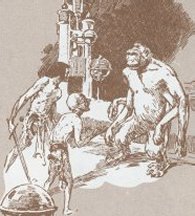 This is very peculiar. What is an apparent, mammal-like, endoskeletal
vertebrate, particularly a semi-bipedal ape creature, doing here in an
ecology otherwise dominated by insects and the Martians we’ve seen.
There is no room, in this ecology, and no time for a single advanced ape-like
vertebrate to evolve. So where does it come from?
This is very peculiar. What is an apparent, mammal-like, endoskeletal
vertebrate, particularly a semi-bipedal ape creature, doing here in an
ecology otherwise dominated by insects and the Martians we’ve seen.
There is no room, in this ecology, and no time for a single advanced ape-like
vertebrate to evolve. So where does it come from?
Why describe this biped creature as an ape at all?
Although these tantalizing lines are all we have, we must assume that Mr.
Cave deliberately chose ‘ape’ rather than man, because its features, appearance,
movement were more apelike than manlike, despite its bipedal nature.
It is still remarkable though, and the ‘white apes’ of
H.G. Wells stick out like sore thumbs in his version of Mars.
One is tempted to speculate that here we may have the inspiration of Burroughs
Great White Apes of Mars.
But apparently, there are not just ‘white apes’ on Wells’
Mars, but something very like humans, as we see in this passage in Chapter
2 of the Second Part of War of the Worlds:
“Their undeniable preference
for men as their source of nourishment is partly explained by the nature
of the remains of the victims they had brought with them as provisions
from Mars. These creatures, to judge from the shrivelled remains that have
fallen into human hands, were bipeds with flimsy, silicious skeletons (almost
like those of the silicious sponges) and feeble musculature, standing about
six feet high and having round, erect heads, and large eyes in flinty sockets.
Two or three of these seem to have been brought in each cylinder, and all
were killed before earth was reached. It was just as well for them, for
the mere attempt to stand upright upon our planet would have broken every
bone in their bodies.”
These bipeds are definitely not Mr. Cave’s ‘white apes.’
They have round erect heads and large eyes in flinty sockets, suggesting
something very close to human. Little more can be told about
them, since obviously, they were killed before reaching Earth, their bodies
shrivelled utterly drained of fluid by the Martians, and now subject to
extensive decomposition and the shock of Earthfall. Whether
their flimsy spongelike skeletons were natural to their lives, or some
side effect of their drainage, shock of impact and decomposition is arguable.
Like the apes, these Manlike creatures are also the prey
of the ‘big head’ martians, and they’re just as inconsistent with the other
glimpses of Martian life that Mr. Cave spies through his egg.
In fact, these Martian humans and apes seem rather more
suggestive of Barsoom. One can, after all, be suspicious that
Burroughs may have read ‘The Crystal Egg’, but we can be almost sure that
he read War of the Worlds.
Like Burroughs' red and green men, and for that matter,
like the Kaldanes, Wells’ Martians are telepathic:
“I watched them closely
time after time, and that I have seen four, five, and (once) six of them
sluggishly performing the most elaborately complicated operations together
without either sound or gesture. I have a certain claim to at least an
elementary knowledge of psychology, and in this matter I am convinced-
as firmly as I am convinced of anything- that the Martians interchanged
thoughts without any physical intermediation. And I have been convinced
of this in spite of strong preconceptions. Before the Martian invasion,
as an occasional reader here or there may remember, I had written with
some little vehemence against the telepathic theory.”
Finally, let’s take a moment to consider the vegetation seen
in the Crystal Egg:
“There were also trees
curious in shape, and in colouring, a deep mossy green and an exquisite
grey, beside a wide and shining canal.... The terrace overhung a thicket
of the most luxuriant and graceful vegetation, and beyond this was a wide
grassy lawn....beyond that, and lined with dense red weeds....
among a forest of moss-like and lichenous trees... that it was these
creatures which owned the great quasi-human buildings and the magnificent
garden that made the broad valley so splendid. ... “
The red weeds, of course, provide another layer of identity
to link ‘The Crystal Egg’ with The War of the Worlds, suggesting
that Wells was using the same ideas for both, or perhaps that the two stories
were genuinely related.
“Apparently the vegetable
kingdom in Mars, instead of having green for a dominant colour, is of a
vivid blood-red tint. At any rate, the seeds which the Martians (intentionally
or accidentally) brought with them gave rise in all cases to red-coloured
growths. Only that known popularly as the red weed, however, gained any
footing in competition with terrestrial forms. The red creeper was quite
a transitory growth, and few people have seen it growing.”
But the descriptions of plants are not too different from
those that Burroughs himself uses, earthly plants with slightly unearthly
colours and shapes. Overall, the description of the fertile
valley is almost similar to that of the Valley Dor.
And finally, let me humorously quote this bit of Wells,
and have the reader think of Burroughs red men:
“The Martians wore no clothing.
Their conceptions of ornament and decorum were necessarily different from
ours; and not only were they evidently much less sensible of changes of
temperature than we are, but changes of pressure do not seem to have affected
their health at all seriously.”
Its almost tempting to see a shadow of influence there.
Did Burroughs initial fantasies involve a heroic Earthman turning the tables
on the Martians, perhaps rescuing a nude, telepathic captive princess from
the tentacled monsters of pure intelligence that preyed upon her race?
It’s almost tempting to see the bald Therns, cannibal intellectuals preying
on the red Martians much as Wells Martians must have preyed upon Wells
Marsmen, as a sort of stepped down version. The sumptuous garden
of the Valley Dor is more than a little reminiscent of the lush valley
seen by Mr. Cave, right down to the ‘white apes.’ And
of course, the Kaldanes of the later Chessmen
of Mars seem strangely reminiscent of Wells invaders. There
are peculiar similarities in the shades and descriptions of vegetation,
as between Burroughs and Wells, perhaps the one coloured the other?
 This
is all just groundless speculation. I’m being mischievous,
after all, if Mr. Lupoff can claim that Arnold’s Gulliver Jones is the
inspiration
for John Carter’s Barsoom, I think that with equal merit, I can offer up
Wells’ Mars as an equivalent inspiration. It’s not at all certain
that Burroughs ever saw Gulliver Jones, but he almost certainly read Wells’
novel, and quite probably his short story. This
is all just groundless speculation. I’m being mischievous,
after all, if Mr. Lupoff can claim that Arnold’s Gulliver Jones is the
inspiration
for John Carter’s Barsoom, I think that with equal merit, I can offer up
Wells’ Mars as an equivalent inspiration. It’s not at all certain
that Burroughs ever saw Gulliver Jones, but he almost certainly read Wells’
novel, and quite probably his short story.
The real truth of the matter, is that all three, and for
that matter, other writers, were truly influenced by the astronomers
of their day, particularly Lowell and Schiaparelli. Their similar
visions of Mars as desperate dying worlds laced by canals and hosting human
and inhuman races is born of the science and prejudices of the day.
But what the hell, I didn’t put White Apes and Humans
on H.G. Wells Mars, he did that himself. And having done
so, we can’t say that perhaps there wasn’t some slight influence on Burroughs.
Barsoom may well include Wells’ Mars, or Wells’ Mars might have contained
the seeds of Barsoom.
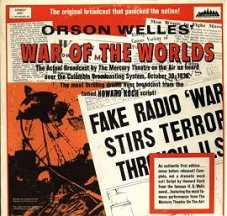
Wellsian
Creatures on Barsoom: Kaldanes and Rykors, Oh My!
Now, take a moment and consider again Wells' descriptions
of his Martian invaders, (dubbed Sarmaks by George Alec Effinger in his
John Carter story, and dubbed Marvaders by certain fans, both names obvious
plays on Martian):
“They were huge round bodies-
or, rather, heads- about four feet in diameter, each body having in front
of it a face. This face had no nostrils- indeed, the Martians do not seem
to have had any sense of smell, but it had a pair of very large darkcoloured
eyes, and just beneath this a kind of fleshy beak. In the back of this
head or body- I scarcely know how to speak of it- was the single tight
tympanic surface, since known to be anatomically an ear, though it must
have been almost useless in our dense air. In a group round the mouth were
sixteen slender, almost whiplike tentacles, arranged in two bunches of
eight each. These bunches have since been named rather aptly, by that distinguished
anatomist, Professor Howes, the hands. .....their physiology differed
strangely from ours. Their organisms did not sleep, any more than the heart
of man sleeps. Since they had no extensive muscular mechanism to recuperate,
that periodical extinction was unknown to them. They had little or no sense
of fatigue, it would seem. On earth they could never have moved without
effort, yet even to the last they kept in action. In twenty-four hours
they did twenty-four hours of work, as even on earth is perhaps the case
with the ants.”
Meanwhile, we have Burroughs' Kaldanes from the Chessmen
of Mars, bodiless heads that ride headless bodies. The
Kaldanes inhabit a lost section of Barsoom called Bantoom.
The Rykors are humanoid bodies, apparently derived from some Barsoomian
primate and cross bred with Barsoomian humans to have only residual heads.
They appear, without Kaldanes, to be crawling creatures, able to breath
and move about, but barely able to feed themselves.:
“The heads were hideously
human and grotesquely inhuman at the same time. The eyes were
far apart and protruding. The nose scarce more than two parallel
vertical slits set vertically above a round hole that was the mouth....
the loathesome head rolled from the body and was now crawling on six short
spider like legs.... two stout chelae which grew just in front of
its legs and resembled an earthly lobster.... he extended a little
bundle of tentacles from the posterior part of the head....”
Wells discusses the internal structure of his Martians, essentially
giant brains with severely atrophied organs:
“The internal anatomy,
I may remark here, as dissection has since shown, was almost equally simple.
The greater part of the structure was the brain, sending enormous nerves
to the eyes, ear, and tactile tentacles. Besides this were the bulky lungs,
into which the mouth opened, and the heart and its vessels.
And this was the sum of the Martian organs. Strange as it may seem to a
human being, all the complex apparatus of digestion, which makes up the
bulk of our bodies, did not exist in the Martians. They were heads- merely
heads. Entrails they had none. They did not eat, much less digest. Instead,
they took the fresh, living blood of other creatures, and injected it into
their own veins. I have myself seen this being done, as I shall mention
in its place. But, squeamish as I may seem, I cannot bring myself to describe
what I could not endure even to continue watching. Let it suffice to say,
blood obtained from a still living animal, in most cases from a human being,
was run directly by means of a little pipette into the recipient canal....
The physiological advantages of the practice of injection are undeniable,
if one thinks of the tremendous waste of human time and energy occasioned
by eating and the digestive process.”
The Kaldanes, similarly, are brains with very little else
going for them, as Ghek tells us in Chessmen of Mars:
“Your brain is bound by
the limitations of your body. Not so ours. With
us, brain is everything. Ninety per centum of our volume is brain.
We have only the simplest of vital organs and they are very small for they
do not have to assist in the support of a complicated system of nerves,
muscle, flesh and bone. We have no lungs for we do not require
air...."
Wells discusses his Martian’s abandonment of bodies:
“Our bodies are half made
up of glands and tubes and organs, occupied in turning heterogeneous food
into blood. The digestive processes and their reaction upon the nervous
system sap our strength and colour our minds. Men go happy or miserable
as they have healthy or unhealthy livers, or sound gastric glands. But
the Martians were lifted beyond human frailties.”
The Kaldanes attitude towards bodies, is flatly contemptuous:
“When your body becomes
fatigued, you are comparatively useless. When it is sick, you are
sick. If it killed you die. You are the slave of a stupid mass
of useless flesh and bone and blood. There is nothing more wonderful
about your carcass than the carcass of a banth. It is only your brain
that makes you superior to a Banth, but your brain is limited by your body.”
And beyond that, Wells discusses their hypothetical origins
and evolution in very Kaldane-like terms:
“It is worthy of remark
that a certain speculative writer of quasi-scientific repute, writing long
before the Martian invasion, did forecast for man a final structure not
unlike the actual Martian condition. His prophecy, I remember, appeared
in November or December, 1893, in a long-defunct publication, the Pall
Mall Budget, and I recall a caricature of it in a pre-Martian periodical
called Punch. He pointed out- writing in a foolish, facetious tone- that
the perfection of mechanical appliances must ultimately supersede limbs;
the perfection of chemical devices, digestion; that such organs as hair,
external nose, teeth, ears, and chin were no longer essential parts of
the human being, and that the tendency of natural selection would lie in
the direction of their steady diminution through the coming ages. The brain
alone remained a cardinal necessity. Only one other part of the body had
a strong case for survival, and that was the hand, "teacher and agent of
the brain." While the rest of the body dwindled, the hands would grow larger.
There is many a true word written in jest, and here in the Martians we
have beyond dispute the actual accomplishment of such a suppression of
the animal side of the organism by the intelligence. To me it is quite
credible that the Martians may be descended from beings not unlike ourselves,
by a gradual development of brain and hands (the latter giving rise to
the two bunches of delicate tentacles at last) at the expense of the rest
of the body. Without the body the brain would, of course, become a mere
selfish intelligence, without any of the emotional substratum of the human
being.”
Meanwhile, the Kaldanes look forward to that same relentless
process of cerebation:
"From the beginning of
time, Nature has laboured arduously towards the consummation of this purpose.
At the very beginning, things existed with life, but with no brain.
Gradually, rudimentary nervous systems and minute brains evolved.
Evolution proceeded. The brains became larger and more powerful.
In us, you see the highest development; but there are those of us who believe
that there is yet another step - that some time in the future, our race
will develop into the super-thing, just brain. The incubus
of legs and chelae and vital organs will be removed.
The future Kaldane will be nothing but a great brain.”
Wells writes:
“We men, with our bicycles
and road-skates, our Lilienthal soaring-machines, our guns and sticks and
so forth, are just in the beginning of the evolution that the Martians
have worked out. They have become practically mere brains, wearing different
bodies according to their needs just as men wear suits of clothes and take
a bicycle in a hurry or an umbrella in the wet.”
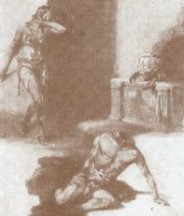 Wells
refers to the Martians Machines, of course. But the Kaldanes
also have bodies that they put on and take off according to their needs,
wearing their Rykors like we wear suits of clothes. Wells
refers to the Martians Machines, of course. But the Kaldanes
also have bodies that they put on and take off according to their needs,
wearing their Rykors like we wear suits of clothes.
There are other similarities. Both races seem
strongly telepathic. Both reproduce asexually, the Wells’ Martians
by budding, and the Kaldanes by clone eggs laid by a single ‘King’.
Thus, with Wells’ Martians and Burrough’s Kaldanes, we
have two creatures that exhibit some physical similarities, but interestingly,
the deeper you go into their philosophies and evolution, the more identical
they become.
I speculated earlier, of course, that Burroughs might
well have taken some inspiration from Wells’ War of the Worlds,
but when it comes to the Chessmen of Mars, its impossible not to
believe that Burroughs had read Wells and that his Kaldanes were influenced
strongly by Wells’ Martians, to the extent that one is clearly related
to or descended from the other.
Clearly, the Kaldanes are Burroughs' adoption and modification
of Wells’ Martians. A tribute or borrowing if you will.
Thus, in any taxonomical sense, the two races are clearly linked.
Thus, we have an interesting bit of reciprocity.
H.G. Wells gave us white apes and humans on his Mars, as well as telepathy
and red and purple vegetation. Burroughs gives us evolved,
bodiless brains committed to cold intellect, wearing bodies like clothes.
Wells and Burroughs Mars now have at least five points of significant overlap.
We have come full circle, H.G. Wells’ Mars is on Barsoom.
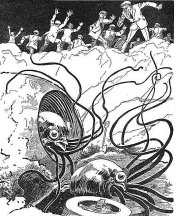
Locating
Wells' Martians on Barsoom
But then, of course, we must ask... If Wells Mars
is Barsoom, then where on Barsoom are Wells Martians?
As always, geography rules. First
let us turn to descriptions of the geography that Mr. Cave sees in his
crystal:
“The view, as Mr. Cave
described it, was invariably of an extensive plain, and he seemed always
to be looking at it from a considerable height, as if from a tower or a
mast. To the east and to the west the plain was bounded at a remote distance
by vast reddish cliffs. These cliffs passed north and south -- receding
in an almost illimitable perspective and fading into the mists of the distance
before they met. He was nearer the eastern set of cliffs....
and passing up the valley exactly parallel with the distant cliffs, was
a broad and mirror-like expanse of water... a wide and shining canal.”
All right, first of all, this is real geography we’re talking
here. Mr. Cave’s view is from a high elevation, perhaps
hundreds of feet in the air, and clear in every direction.
The features he sees are entirely unambiguous, and more, they seem large
enough and distinctive enough to actually be able to locate.
This isn’t a case, for instance, of some guy who describes his home as
‘between a couple of low hills, with a winding river,’ rather, the geography
described should stand out like a sore thumb.
This is a large plain, likely several miles, or even dozens
of miles across, bounded on both sides by ranges of red cliffs.
These cliffs run roughly north to south, and are vast and immense,
so extensive that they vanish into the distance without apparent diminishment.
A river or canal runs down the centre. And obviously, we have
to be in the northern hemisphere, or no lower than the equator, because
we can see northern hemisphere stars from this valley.
Okay, so with a description like that, it should be hard
to miss. The first thought, of course, whenever we think of
a giant valley on Mars with high cliff walls, is obviously Valles Marinis,
but unfortunately, that immense canyon system runs east to west, not north
to south. Besides, on Barsoom, the Valles Marinis is well established
as being the site of the Toonolian Marshes for over half its length, and
as identified broken canyons and forest areas for the balance, the whole
area being well colonized by red man city states, so there’s no room for
Wells' Martians there.
But here’s the truly interesting thing. If
we go and look at the MOLA topographic Map of Mars (never leave home without
it) we can actually find a little piece of Mars that fits our requirements.
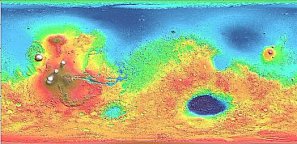
http://ltpwww.gsfc.nasa.gov/tharsis/Mars_topography_from_MOLA/
If we take a look at the area of Mars known as the Tharsis
(the big brown mass with white spots) highlands, and if we look further
on the left side, between the immense central volcano Olympus Mons (the
big white spot), and the group of volcanoes collectively known as
Tharsis Montes (the central trio of white spots), we see a remarkable feature
resembling the spikes of a green trident sticking out from Tharsis.
This is the area of approximately 5 degrees latitude, and -140 degrees
longitude on the topographic map.
Now, if you are employing the internet version of the
Topographic map, you can actually zoom in on features. We can
see close up on this little trident feature, and we’ll see that the central
prong of the trident is actually a long straight cliff or mountain range,
moving roughly north/south (actually, slightly off true north, perhaps
northwest), as is the inner prong of the trident, closest to Tharsis.
Effectively, what we have here is a wide, deep, flat valley running and
opening between two roughly north/south straight cliff ranges.
In short, we seem to have found a far better geographical match than we
deserve.
And, of course, there is more. The Tharsis
mound is a highland region, the highest on Mars. Created by volcanic
uplift, it is well above the level of Barsoomian clouds.
As with mountain ranges on Earth, it’s a barrier to water bearing clouds
and water vapours. Thus, we can expect that water clouds and
moisture in the atmosphere, travelling through the air, encounters the
Tharsis barrier and can go no further. The clouds, bunching up like
a traffic jam, release their moisture as rain, or as streams and rivers
flowing down the Tharsis cliffs. And of course, where geography
shapes or guides the clouds and moisture into geographical corners and
cul de sacs you will get an accumulation of water.
Thus, our valley, bordered by two sets of cliffs, and
extending out from Tharsis, just south of the largest mountain on Mars,
is likely to be extremely well watered, with a healthy river or canal extending
out upon Barsoom. This explains the lushness, as compared to
most of Barsoom. It fits.
This area is in a largely unexplored portion of Barsoom,
the impenetrable and barren Tharsis highland acts as a barrier to exploration
from the east, and the western cliffs would also act to conceal it.
Cartographers or explorers would take the Western cliffs as the beginnings
of Tharsis, and not the sign of a valley. Only by entering
the mouth of the Valley would it be discovered.
And of course, there are a couple of collateral bits of
evidence. It is just north of the area we have provisionally identified
as the Kaldane’s Bantoom, and there is speculation that Wells Martians
may well be related to the Kaldanes.
Meanwhile, it is south of the area of Tempus Terra in
the northern edges of the Tharsis Mound, an area we have identified provisionally
as the Opal Sea and Hither lands of Gulliver Jones. In the
League of Extraordinary Gentlemen, of course, Gulliver Jones is
depicted as leading his Hither against the Martians. And geographically
at least, this seems feasible. Gulliver would simply have lead his
people around the edge of Tharsis, skirting Olympus Mons and then heading
straight down south.
Further, the redoubt or fortress of the Martians in Alan
Moore’s comic, is depicted as being inside an immense valley surmounted
by high cliffs on either side.... A valley mis-identified by some
as Valles Marinis, but whose appearance and description match may match
well enough to the trident valley we’ve identified on the topographic map.
Around on the other side of Tharsis, and comfortably back
in Burroughs, is the shallow end of Valles Marinis, hosting dried forested
portions of the Kaolian region, inhabited by at least a few species of
giant insect, notably the wasplike sith.
A final thought takes us back to Wells. Obviously,
the most benign spot for the Martians to launch their cylinders would be
from the Equator. And in order to construct their immense cannon,
they would need access to both vast amounts of energy and metals.
The volcanic Tharsis region would probably be the richest source of minerals
and geothermal energy on the planet, as well as a perfect launch site.
In short, not only is the geography of Wells’ Martian
region consistent with a bit of real geography on the actual Mars, but
it fits in quite well with Burroughs Barsoom, and with Alan Moore’s pastiche.
Evolution
of Wells' Martians on Barsoom
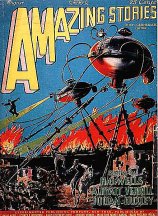 Here is the problem. How shall I put it?
Wells’ Martians seem biologically.... Inconsistent, on Barsoom.
Just as Wells’ apes and humans seem somewhat inconsistent on his Mars.
Here is the problem. How shall I put it?
Wells’ Martians seem biologically.... Inconsistent, on Barsoom.
Just as Wells’ apes and humans seem somewhat inconsistent on his Mars.
Think about it. Barsoom is wall to wall vertebrates,
everything has an internal skeleton, and all too often, way too many limbs.
There’s no shortage of bone and muscle, tooth and claw, and animal attributes
of every sort.
Meanwhile, the Kaldanes seem peculiarly out of place.
Obviously, they’re not vertebrates, they are not creatures of internal
skeletons. They possess insectlike legs and chelae.
Wells’ Martians with their soft round bodies, waving tentacles and rudimentary
organs seem similarly foreign to the Barsoomian ecology that we know.
The Wells’ Martian life we see in the crystal egg includes a flying species,
equally alien to Barsoom as we know it, with both tentacles and insectlike
legs, and further, most of the fauna we see through Wells crystal egg is
insect life, including gigantic beetles.
So where do these creatures come from?
Allan Moore, in his League of Extraordinary Gentlemen seems to have
Gulliver Jones and John Carter suggesting that Wells’ Martians are themselves
alien invaders to Mars. Essentially, that they’re foreign to
Barsoom. Moore obviously was wrestling, in part, with the same
problem that I am. The Wells’ Martians obviously seem foreign
to the ecological context of Barsoomian life. They don’t
seem to fit.
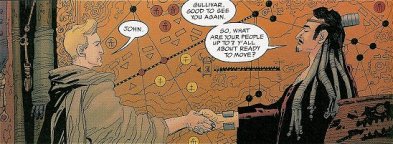
This theory is espoused by fans and Wold Newton writers,
and even by later day science fiction, such as the 1980's War of the
Worlds TV series which acknowledged Mars was a dead planet, and therefore
the invaders must be from farther out.
Well, the ‘alien hypothesis’ would solve a lot of problems,
but it doesn’t seem to hold up.
In Burroughs Chessmen of Mars, it seems clear that
the Kaldanes evolved as a sort of spider or insect. Specifically,
the Kaldanes co-evolved with their Rykors, and are definitely home grown
Barsoomians. This poses a problem.
The Kaldanes are all too clearly close relatives to Wells Martians.
If the Kaldanes are home grown, then so are Wells Martians.
Moreover, Wells himself, in both his “Crystal Egg” and
his War of the Worlds offers no suggestion that his Martians are
from anywhere but Mars. Quite clearly, their evolution is consistent
with his view of Mars as an ancient and dying world.
So on a strict reading of the canonical text, it seems
that they are stuck on and with Barsoom.
Alan Moore’s version of John Carter notwithstanding, the
Wells' Martians are local boys, just like the Kaldanes, Green Men, Red
Men, Hither, etc. It should be noted that John Carter, in Moore,
is bent on genocide. He’s united the entire rest of the planet with
the sole objective of wiping these creatures out, so it may make sense
that he refers to them as foreign invaders.
Wells gives no taxonomy or evolution for the Martians,
at one point, he warns that they could have evolved from creatures like
us, but in the "Crystal Egg," he seems to place them in an ecology dominated
by, or based on, insects, which suggests that they are ultimately some
form of insect life.
(On the logic that if the dominant lifeform is a big critter,
and your planet’s ecology is dominated by dinosaurs, then your dominant
critter is a dinosaur, or if your ecology is dominated by mammals, the
apex creature, Man, is probably a mammal).
So, what are we to make of this? The most
rational conclusion is that both the Kaldanes and Wells’ Martians are highly
evolved insect life forms. Well, evolution doesn’t just
produce one off's or happy monsters. If you had highly evolved
insect forms like Wells’ Martians and Burroughs' Kaldanes, you have to
have a variety of other evolved insects, effectively, several lines of
species, and even an insect ecology.
And in fact, this is what Wells’ shows us through the
"Crystal Egg." Interestingly, Burroughs also hints at other
highly evolved insects in the form of the Sith, a giant wasp of the Kaolian
forest, and the giant spiders of Ghasta in the southern hemisphere.
It’s hard to see how Burroughs' own giant insects, the Sith and Spiders
could have evolved in ecologies so dominated by vertebrates.
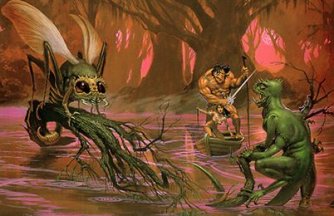 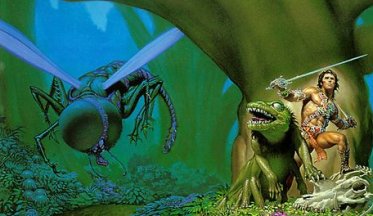
The conclusion must be that on Barsoom, there
was a parallel, isolated ecology of insect life, separate from the principal
ecologies of the vertebrate life. Where was this?
We can rule out the life around the polar ocean.
Although divided into three lobes or great seas, all of these ocean shores
would have been filled by fish and colonized by various sorts of lobe fin
fish. Thus, the oceans and their shores would be dominated
by vertebrate life.
The Hellas Basin, or Torquas Sea, had conditions far too
similar to the ocean shores, and was likely colonized by vertebrate life
moving overland from several directions. The ring of uplands
around Hellas was too gradual, and broken in too many places to prevent
infiltration from the species moving out from the shorelines.
Meanwhile, the Argyre basin, the site of the Valley Dor
and Sea of Korus, appears to have evolved as a plant utopia, eventually
producing carnivorous plants and the remarkable plant men.
In contrast, the insect utopia that produced the Kaldanes
and other remarkable forms, has to have four requirements:
1) It had to be remote from the other
areas and geographically distinct, there had to be physical barriers of
some sort to prevent Vertebrate life from invading and overwhelming the
insect forms, or vice versa (depending on which line of evolution was advancing
first and which had the most potential). In short, it had to
be literally locked off or isolated.
2) It had to be reasonably hospitable to life.
Obviously, we couldn’t be looking at a sparse desert, but rather, something
hospitable enough and stable enough that it could support a rich distinctive
ecology, and the opportunity for that ecology to refine and diversify itself
over millions of years.
3) But it had to have conditions sufficiently
different from those the vertebrates thrived in that they could not easily
colonize the region. In short, there had to be a certain
degree of ‘unfriendliness’ whether this be in the severity of seasons,
the distribution of water, the average temperatures, temperature extremes,
etc.
4) There has to be some geographical relationship
of sophisticated insect species now, even assuming that they diffused out
of their homeland. For instance, we don’t see Kangaroos
in England, nor do we see Bears in New Zealand. However, we
do see Kangaroos in New Guineau, which was once connected to Australia.
And we can trace Bears from Europe to Asia to North America, areas which
are or were all geographically related. By this same token,
we should be reluctant to assume that major insect species simply plopped
down randomly on the planet, or evolved in the regions that they are now
in. Rather, we should assume that they evolved in some central
or common region, and either remained there or traveled to their current
habitats in sensible ways.
In fact, the area of Mars most likely to satisfy all of these
conditions is roughly where we find the Kaldanes and Wells Martians.
Just south, in the shadow of the Tharsis bulge: This would
be a region, protected through much of its northern area by the Tharsis
cliffs and highlands, an impassable barrier for life on Mars. Directly
south is the South pole. On the East and West, this area is about
as far as you can get from either the Hellas or Argyre sea basins, both
of which are isolated by mountain and highland barriers. From either
of these basins, you would have to pass through a lot of extremely rough
and unforgiving desert and mountain territory to get to this region.
Further, the region just below Tharsis is itself broken up by low mountain
and highland barriers. In short, it is likely to be (and still
is in John Carter’s time) one of the most difficult and inaccessible regions
on the planet. So, it’s a perfect site for an ecological island.
However, the harsh and inaccessible conditions of the
surrounding terrain do not necessarily mean that this region itself is
harsh. It is likely to be well watered by drainage down from
Tharsis, and its edges are close enough to the polar seas that primitive
life might well make it into the region from time to time, depending on
climactic conditions. Such life might well find a potential
garden of Eden with all the requirements to support a blooming ecology.
Of course, garden of eden is a relative term.
Normally, for life, Martian nights and days elsewhere are moderated by
the polar ocean or the south hemisphere seas. These large bodies
of water regulate climate by soaking up heat during the day and releasing
it during the night, much as oceans and seas do on Earth. Thus,
in the lowland regions of these areas, the climate is pretty steady, from
day to night and from summer to winter. The temperature changes,
but the fluctuations are not savagely extreme. On the
other hand, without a large body of water to regulate temperatures, fluctuations
become extreme, days are sweltering, nights are freezing, summers are blistering,
winters are savage. I have personal experience of this, having
grown up on the Atlantic coast and moved out to the Canadian prairies.
One could only expect that conditions on Barsoom beneath Tharsis, well
away from any moderating body of water, would be more extreme.
These strong fluctuations in temperature would certainly act as a barrier
to more advanced vertebrates, who were more adapted to relatively stable
climates. The temperature ranges would get them, again and
again. Even for desert adapted vertebrates more used to temperature
ranges, the large amounts of moisture and water in the region would combine
with temperature to form a barrier. It wouldn’t keep the vertebrates
out of the region forever, but it would hold them off for a good long time,
allowing life in this region to develop in its own way.
Finally, it makes sense in terms of the dispersal that
we are familiar with. The Kaldanes of Bantoom are still in
or near the homeland. The Wells’ Martians have clearly
moved out, occupying a valley once bordering an ancient sea, but still
hugging the line of the Tharsis bulge. The Sith of the Kaolian forest
has also followed the Tharsis bulge, moving even further. Meanwhile,
the spiders of Ghasta have spread within the southern hemisphere, not too
far from the homeland. The species distribution either diffuses
overland through the southern hemisphere, or follows the outlines of Tharsis.
It works.
Here we might expect Barsoomian insects to evolve into
sophisticated and gigantic forms over long ages, and to even develop sophisticated
brains and societies. Of course, the Insect Utopia would
not endure indefinitely on Barsoom.
Sooner or later, the vertebrates would evolve to the point
where their species would invade the insect regions. Among the earliest
invaders might have been the Great White Apes and Banths who seem ubiquitous
across the planet. We note that in Bantoom, the Rykors have
long been incorporated into the Kaldane’s evolution and society, and that
they are familiar with the depredations of Banths (although practically
no other vertebrate animal intrudes). Even in the Wells’ Martians
secluded valley, white apes appear. Life adapts, evolves and
expands. It is inevitable that life forms would spread to every
point they could reach, and as they grew more sophisticated and adaptable,
their reach would expand. Eventually, the insect utopia would
be breached.
The result would be a mass extinction of much of the sophisticated
insect life. It’s likely that the insects of Barsoom,
as on Earth, simply had less potential and more handicaps than the vertebrates.
With more potential to exploit, the vertebrates would inevitably out-compete
and wipe out most insects. There’s also the comparative sizes of
the two competing ecologies. The Insect Utopia occupied at
most, a fertile crescent in the shadows of Tharsis and some hinterlands.
A few million square miles at most. In comparison, vertebrate
life dominated the polar sea shorelines and lowlands as well as the Hellas
basin. Their territory was tens of millions of square miles.
Competitive pressures were stronger in the diverse and manifold vertebrate
regions, their species were more adaptable and robust.
It would be similar to that experienced when old world
fauna invaded through North America into South America. Many
South American species, with less potential, from a smaller ecological
area and therefore less robust, were simply wiped out.
Pockets of insect life would survive in isolated regions,
of course. The heartlands of insect utopia would provide the
best refuges for insects and the greatest challenges for vertebrates.
The more robust insects would fight back against the vertebrate invasion,
surviving in the new ecology and even spreading into vertebrate regions,
as we see with the spiders and sith. The vertebrates would
incorporate these new insect species into their ecology, just as, in certain
areas, vertebrates would be incorporated into the bastions of the remaining
insect ecology.
It would be at this point that the Kaldanes and Wells
two races of Martian would split off from each other, maintaining their
own isolated ecological enclaves. The Kaldanes clearly began
to enter into symbiotic relationships with host vertebrates, suggesting
that their areas had become a mixed insect/vertebrate ecology.
The Wells’ races of Martians, in contrast, appeared to have remained much
further in the core of the remaining pure insect ecology. Without
the limitations of symbiotic vertebrates, the big heads became even bigger,
doubtless using their mental faculties to best advantage. The
big heads eventually began to prey on vertebrates, but vertebrates remained
a relatively small part of the ecology in these areas. The
flyers likely dominated the cliffsides of Tharsis.
As Barsoom began its long decline, and the seas vanished,
it appears that the big heads and flyers left the shadow of Tharsis, whose
environment had begun to deteriorate, and moved to a sheltered valley adjacent
one of the former seas. They were clearly seeking a more stable
geographical area, and a watered river or canal valley bounded on both
sides by long impenetrable cliffs would be both eminently defensible and
feature extremely stable climate.
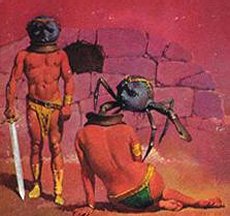 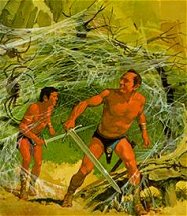
A
Little Problem
There is one small obstacle to unifying Wells and Burroughs
Mars. Wells’ Mars had themselves quite a loud and nasty invasion
of Earth, round about 1898-1899. Neither John Carter
nor any other of Burroughs protagonists, in the series, ever actually refer
or say anything that could be construed as a reference to this invasion.
This has got to be a pretty big gap. After
all, one can imagine that if Martians with tentacles and crap like that
had trashed England in their giant machines, this would have certainly
coloured views for a long time. John Carter’s arrival
on Barsoom was around 1867 or thereabouts, so obviously, wouldn’t have
been influenced by the War of the Worlds.
But why on Earth would Gulliver Jones or Ulysses Paxton
want to go there, given that their journeys were taking place well after
the Martian invasions, when presumably everyone knew what the Martians
were like?
In the case of Jones, we might make an excuse or two for
him, his adventures were published in 1905, so they occurred before this.
It is possible that his journey to Mars occurred before the War of the
Worlds.
On the other hand, Paxton goes to Mars during WWI, around
1917, or nearly twenty years after the Martian Invasion. Surely
he’s got to suspect that its not all Red Princesses and Green Men.
But there’s never a mention or a hint, not even so much
as an awkward silence. That’s a bit hard to swallow.
Of course, we can offer some fairly speculative explanations.
We can assume that the world was not so tightly woven
together in those days. Thus, for America and for Europe, England
was a remote far off country. In 2001, the entire world watched
the World Trade Centres fall. But 1899 is a different country, communication
is slower and less immediate. The telegraph could splash the
news of the Martian invasion of England onto front pages in America, but
the information will come through laboriously slow as a series of dots
and dashes, there will be no photographs, descriptions and reports will
be terse and second hand. There won’t be front page photos,
live television, or endless camcorder records. At best, you’ll
get a few badly drawn sketches based on secondhand information.
In short, for much of the world, the impact of a Martian
invasion of England, might not have the same immediate and worldwide impact
as a major terrorist attack or disaster like the Tsunami in the modern
day.
The world of 1899 was far more accepting of the notion
of life, of intelligent life, on other worlds, so that would not necessarily
have been as shocking. Meanwhile, a number of factors would
have limited the shock and acted to restore complacency. The
invasion seemed confined to England, and the invasion was remarkably short
lived, only a matter of weeks. Finally, the Martians simply were
unable to cope with Earth’s conditions, clearly shutting the door on the
whole matter.
So, one might imagine a stir for a year or two, but eventually,
people would settle down, get on with their lives and forget about it.
Particularly when no further invasions are forthcoming. I imagine
the English would still be somewhat traumatized, but John Carter, Gulliver
Jones and Ulysses Paxton are all Americans.
One thing which would certainly insert itself into public
consciousness is the fact that there are humans, or humanoids on Mars,
in addition to the ugly Wells creatures. So, doubtless all
sorts of fancies or fantasies would be spun to the public to explain both
humans and the failure of the big heads to return.
Of course, this might explain the failure of the War
of the Worlds to create a big long lasting ripple. But still,
there must have been some awkward moments between Carter and his nephew.
Indeed, if we’re willing to read generously into Burroughs
canon, one very peculiar fact does stand out. There are, awkward
pauses for which there is no apparent explanation.
Consider, according to these timelines:
http://www.xenite.org/edgar_rice_burroughs/barsoom_chronicles/timeline.html
http://www.erbzine.com/mag0/0051.html
John Carter goes to Mars originally in 1866, returns
to Earth in 1876 and leaves for Barsoom again in 1886, after which Burroughs
finds his manuscript for Princess of Mars.
In 1898, John Carter returns to visit Burroughs and tell
him of his and his son’s adventures. This is just before the
War of the Worlds, which likely takes place sometime between 1898
and 1900 (call it 1899). So obviously, the conversations and
discussions between them are not tainted by the War of the Worlds.
But then, following the War of the Worlds, there
is a twenty seven year gap to John Carter’s next visit in 1925.
Well, that’s a huge awkward silence, is it not? It seems
a cold chill has descended between Earth and Mars for an entire generation,
possibly as an indirect result of the Martian invasion?
The next contact is five years later, via Paxton and the
Gridley Wave, in 1935. And ten years later, in 1940, there
is another Gridley Wave transmission from Paxton.
Now, here’s something very peculiar. Despite
the clear fact that Burroughs is receiving Gridley Wave transmissions in
the '30s and '40s, there is no official contact between Mars and Earth
until the Moon Maid reports it in 1967.
Again, there’s an inexplicable cold radio silence for
thirty years, where the channels seem open, but Earth isn’t officially
willing to receive. Is this further evidence of fallout of
chill from the War of the Worlds?
Or how about this: Although Burroughs
has received the Princess of Mars manuscript as early as 1886, and
hears the next three stories by 1898, it isn’t until decades have passed
before Princess of Mars is published in 1912, with the three succeeding
stories coming out of the next decade.
Now, it may be curious why Burroughs does not publish
John Carter’s manuscript between 1886 and 1898, but perhaps he feels no
need to do so. It’s an odd curio. However, in 1898, he’s
now in possession of no less than four manuscripts.... So why
does it take well over a decade to publish them?
Or for that matter, Arnold’s Gulliver Jones may
well take place prior to 1898, but is not published until 1905. Why
the delay?
Because, in 1899, the Martian invasion occurs, and after
that, adventures of humans on Mars are literary poison. The public
has well established ideas of what Martians look like, what Mars is like,
and what the relationship to earth is, all horrible, and simply will not
look at anything that deviates from those ideas.
Over time, the idea of humans on Mars percolates through
of course. The shock of the invasion wears off.
The trauma diminishes, and slowly, people become more open.
As the ‘big head’ Martians become trite and cliched, people become more
and more fascinated by the tantalizing evidence that there are indeed human
martians, whose remains were found in the invaders capsules.
The ‘literary chill’ is so profound that it takes Arnold
six years to publish Gulliver, which essentially merely tests the
waters and is unsuccessful. Burroughs waits a full thirteen
years for the sting of the Martian invasion to fade before offering up
John Carter’s manuscript, and only after it is successful, does he release
the others, one at a time, all of the time, carefully avoiding the very
impolitic fact of the invasion.
Only after the manuscripts success is confirmed, does
John Carter dare to return to earth to carry on his relationship with is
nephew. How John Carter determines that the manuscripts have
been successful is another question. He may simply have decided
to wait a good decade before checking things out.
Despite the thawing of the literary and social chill,
of course, there is a political chill. Thus gridley wave radio contact
between the two worlds is ignored by Earth governments and scientists for
a generation between 1935 and 1940 and 1967.
And of course, the only effort to actually go to Mars
is by Carson, who is a bit of a daredevil in 1930. He
may not even have been born at the time of the Martian invasion, so he’s
clearly not deterred from wanting to go and check the place out.
Indeed, he’s probably intrigued by the mystery of the ‘big heads’ failure
to follow up their invasion, and the reports of humans on Mars.
Earth governments have no interest whatsoever in sending
a ship to that clearly hostile world, no sense looking for trouble,
until well after peaceful communication is established in 1967, and the
‘Big Heads’ are confirmed to be long gone.
Essentially then, it might just be possible to actually
read in the ‘big awkward silences’ some hints that Wells' War of the
Worlds occurred on Burroughs Earth, and has resulted in a certain delicacy
and avoidance around the topic.
Finally, and this is obviously conjecture on my part,
the War of the Worlds may well have had an impact on Burroughs Earth.
In the Moon Maid, Burroughs writes that the first world war continued,
almost uninterrupted, off and on until the 1960s on Earth.
In our world, of course, there was an almost 20 year gap between the two
world wars, to be followed by a cold war through the '60s.
In Burroughs world, the war seems to have been an almost continuous, generations
spanning conflict, with perhaps shorter periods of peace and stability.
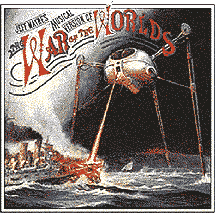 Wells, in War of the Worlds, writes that human inventors found Martian
machines to be fertile inspiration for their inventions. The
implication is that the alien technology of the Martians has boosted Earth
technology in some respects.
Wells, in War of the Worlds, writes that human inventors found Martian
machines to be fertile inspiration for their inventions. The
implication is that the alien technology of the Martians has boosted Earth
technology in some respects.
At least some of those boosts would be in military technology,
the Martians were using poison gas, for instance, fifteen years before
humans would.
So, is it possible that the influx of useable Martian
technology helped to prolongue and extend Earth’s World War, so that instead
of a couple of short, sharp, brutal conflicts, Burroughs world ended up
in a long dragged out affair? Something to think about.
John
Carter's War of the Worlds
Of course, Burroughs and Wells were dealing with copyright
issues in their day, and as working writers, knew better to step on each
others toes. They would have each recognized that they were
doing radically different things with their Mars, and the others versions
of Mars would not have been all that compatible with what they were doing,
or what they were interested in doing.
But, not so the modern day, where a couple of reputable
professionally published writers of literary reputation have boldly stepped
into the fray and shown John Carter fighting the War of the Worlds on Barsoom.
I’m frankly of mixed minds on this stuff.
The minute you step away from canonical sources, you enter dangerous territory.
In particular, its dangerous to mix media, to go from novels to comics
to movies, as each tends to modify the material. This is precisely
where so much of the Wold Newton stuff goes off the rails, by mixing media
and failing to distinguish canonical and noncanonical material.
But in this case, I think that without fully accepting
the George Alec Effinger and Alan Moore stories, we should acknowledge
that these are both writers of high literary and popular reputation, who
in these and other works exhibit a well known fidelity to their source
materials, and whose pastiches are commercially and professionally published.
So, call it semi-canonical. Something we can play with, and
even, with reservations, accept.
Effinger opens up John Carter’s War of the Worlds with
the beginning of the story. In short order, we’re shown Carter
at peace in Helium, the discovery of the kidnapping of Dejah Thoris, his
travel to the formerly unknown land of the Sarmaks where the big gun is
in preparation... And after that, it offers only hints and outlines,
while reassuring us that everything turned out in the end and the threat
is ended.
Alan Moore, on the other hand, delivers us the end of
the story. John Carter, as the Warlord of Mars, has put together
a worldwide coalition of races and nations to obliterate the Sarmaks from
existence. Gulliver Jones is part of John Carter’s alliance.
There is a clear reference to Dejah Thoris, and unpleasant things having
happened to her, but its not clear whether she’s living or dead, free or
still a hostage, healthy or injured. The Sarmak have
clearly been pushed back through their valley, to their final redoubt,
and as the walls of their fortress are breached, and their race slaughtered,
they launch their final capsules towards Earth.
There are numerous small discrepancies in Moore’s comic
from the canonical sources: Gulliver flies on his carpet, but in the novel,
it wraps around him like a cocoon, the Thoats have clawed feet rather than
nailless hooves, Gulliver’s look and dress are reminiscent of Laurence
of Arabia, while John Carter’s look and costume seem to be some hybrid
between British officer and oriental potentate. They’ve both
become rather English.
But despite this, we can at least reasonably accept that
George Alec Effinger has given us the beginning, and Alan Moore has provided
us with the end, of the story that Edgar Rice Burroughs never told, the
missing saga of John Carter’s life. The middle, of course,
remains unknown and unknowable.
And here, I will leave it to the reader....
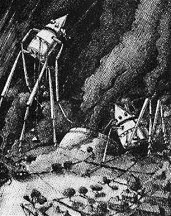 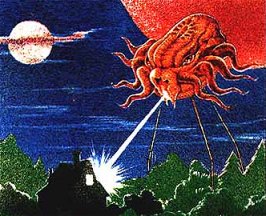 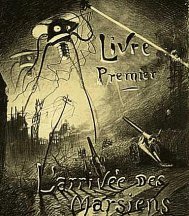
|
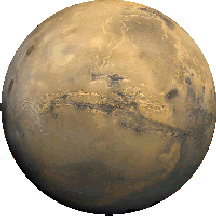 . . .. . .
. . .. . . 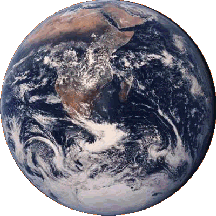










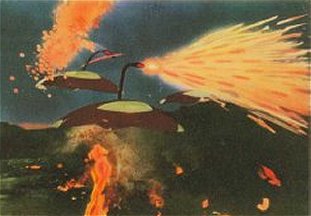
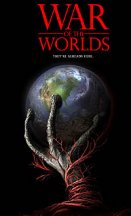
![]()

![]()